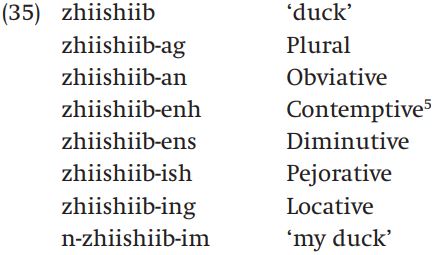


 Grammar
Grammar
 Tenses
Tenses
 Present
Present
 Past
Past
 Future
Future
 Parts Of Speech
Parts Of Speech
 Nouns
Nouns
 Verbs
Verbs
 Adverbs
Adverbs
 Adjectives
Adjectives
 Pronouns
Pronouns
 Pre Position
Pre Position
 Preposition by function
Preposition by function 
 Preposition by construction
Preposition by construction
 Conjunctions
Conjunctions
 Interjections
Interjections
 Grammar Rules
Grammar Rules
 Linguistics
Linguistics
 Semantics
Semantics
 Pragmatics
Pragmatics
 Reading Comprehension
Reading Comprehension|
Read More
Date: 2023-08-22
Date: 2023-09-02
Date: 2023-08-28
|
Nishnaabemwin (Algonquian)
The final language we will look at is Nishnaabemwin, an Algonquian language spoken in southern Ontario, Canada (Valentine 2001). It makes heavy use of affixation, especially suffixation, and has an extremely rich system of inflection. What’s most interesting about Nishnaabemwin, however, is the way that it combines bound morphemes to form new lexemes.
Let’s look first at inflection. Nouns have either animate or inanimate gender. They can be inflected for number, and have different forms for diminutive, pejorative, and what is called ‘contemptive’, a suffix that adds a negative meaning, but one that is less strongly negative than the pejorative suffix. Nouns can also occur in a locative form, and what is called the ‘obviative’ form, which serves to distance a noun from the speaker in a narrative. Finally, there are prefixes and suffixes that indicate possession of a noun. Some of the relevant forms for the noun zhiishiib ‘duck’ are given in (35):

These inflections are not mutually exclusive. If they occur in combination, the diminutive, for example, must precede the pejorative, which in turn precedes the suffix that occurs in the possessive. Nor are these the only inflections that can appear on nouns: this is just a small selection!
Verb inflection is even more complex than noun inflection, and we cannot really do justice to it here. But just to give you a taste of how verintricate the inflection of verbs is in Nishnaabemwin, consider Valentine’s (2001: 219) description of the inflectional possibilities of intransitive verbs that take animate subjects:
The independent form of the verb is used in main clauses, and differently inflected forms are used in subordinate clauses (the conjunct form) and in imperatives. By polarities, Valentine means that verbs have different forms for positive and negative. Compare this to the four forms of the verb walk in English (walk, walks, walked, walking); English uses the same forms of the verb in main and subordinate clauses, and uses a separate word for negation.
Derivation is no less complex than inflection in this language: words rarely consist of a single root morpheme. Instead, various bound morphemes are joined together to form words. Intransitive verbs, for example, frequently consist of two or three pieces. The last piece, called the ‘final’, expresses a verbal concept. The first piece, called the ‘initial’, expresses something that modifies the verbal concept; in English we would express similar concepts with separate adjectives, adverbs, or prepositions:

Verbs may also have a third piece that occurs between the initial and the final; this is called the ‘medial’ and corresponds to what in English would usually be a nominal concept (Valentine 2001: 330, 334):

Such forms can undergo further derivation by adding another final element, so from gaagiijndbe ‘have a sore head’ we can get gaagiijndbekaazo, which means ‘pretend to have a sore head’ by adding the final -kaazo, which means ‘pretend to’. And of course each of these verbs can then take various inflectional elements.
Nouns can be made up of several bound morphemes as well. For example, the nouns in (38a) are made up of an initial bound element that has an adjectival sort of meaning, and a second bound element that means ‘thing’. Those in (38b) have an initial element that is a free form, and a bound final element that means ‘building, habitation':

Valentine uses terms like ‘initial’, ‘medial’, and ‘final’, rather than calling the bound morphemes that make up these forms ‘prefixes’ or ‘suffixes’, probably because these morphemes are much more like roots than like affixes in their meanings. We might therefore think of them as bound bases.
There are some derivational suffixes in Nishnaabemwin, however. For example the suffix -aagan creates nouns from one class of transitive verbs:

And Nishnaabemwin also has compounds, which differ from the forms in (38) by being composed of two independent stems (Valentine 2001: 516–17):

One thing that is striking about the morphological system of Nishnaabemwin is the overall complexity of words: words rarely consist of a single morpheme, and frequently consist of many morphemes.
|
|
|
|
لخفض ضغط الدم.. دراسة تحدد "تمارين مهمة"
|
|
|
|
|
|
|
طال انتظارها.. ميزة جديدة من "واتساب" تعزز الخصوصية
|
|
|
|
|
|
|
مشاتل الكفيل تزيّن مجمّع أبي الفضل العبّاس (عليه السلام) بالورد استعدادًا لحفل التخرج المركزي
|
|
|